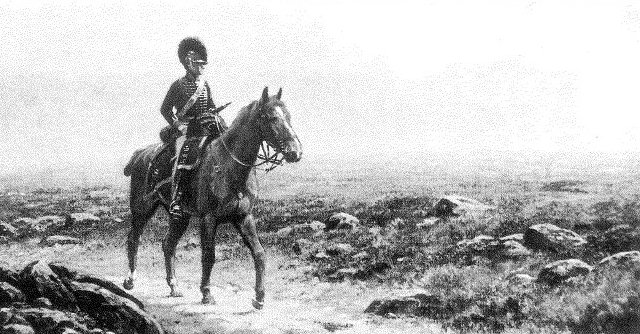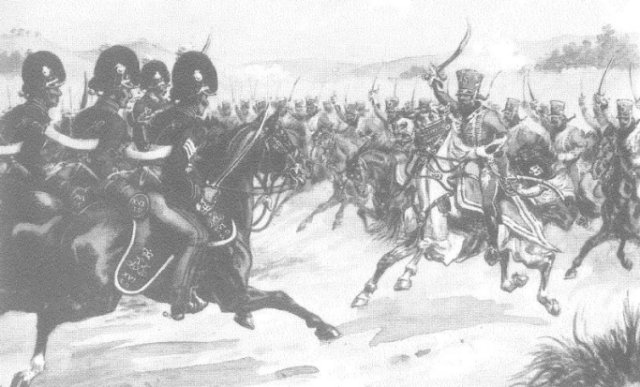
The Peninsula Campaign 1809-1814
On March the 31st 1809, the 16th Light Dragoons, commanded by Colonel George Anson, sailed from Falmouth and disembarked at Lisbon on April 13th. The regiment was immediately brigaded with the 14th Light Dragoons, the brigade being commanded by Major General Stapleton Cotton. The regiment first saw action during the operation to cross the Douro in March 1809 and on May 16th they attacked the French rearguard at Salamonde.

The 16th Light Dragoons earned its first battle honour of the war at Talevera on July 27th to the 28th, 1809 where 13 men were lost.
The regiment spent the winter on the Tagus, and in spring 1810 was attached to Robert Craufurd's Light Division. During July of that year the regiment skirmished frequently with the enemy outposts, and on July 11th was involved in the ill-fated attack on a small French unit at Barquilla. During the retreat to the position at Busaco the regiment played an active part in covering the movements of the army and again clashed with French cavalry.
The 16th Light Dragoons were present at Busaco on September 27th 1810 but took no part in the battle.
When the Allied army reached Torres Vedras in October 1810 the 16th were stationed in quarters in Mafra, and later Ramalhal. The regiment pursued Massena's retreating army in November 1810 when it withdrew in front of the lines and during the next few months clashed with the French rearguard.
The regiment's next major engagement came at Fuentes de OÑoro, from the May 3rd to the 5th, 1811. Casualties were light. Following which they went in to quarters on the Spanish border.

The period between January and April 1812 was spent covering the siege operations at Cuidad Rodrigo and Badajoz respectively, a task undertaken by many of Wellington's cavalry regiments. On April 11th 1812 the regiment took part in the cavalry action at Llerena taking scores of prisoners and were mentioned in Cotton's dispatch. The regiment took part in the battle of Salamanca on July 22nd 1812 and afterwards went in to cantonments on the Duoro while Wellington marched on Madrid.
In October 1812 the 16th found themselves covering the siege operations at Burgos, and during the retreat from there fought a hot action on 23rd October on the Pisuerga River, losing some 62 officers and men.
During the winter of 1812-13, the regiment occupied quarters in Aviero and did not enter Spain again until May 1813 when Wellington began the advance that would take him to Vittoria. On June 21st the 16th fought in the great battle there losing 21 men during the day. There was little scope for serious action during the operations in the Pyrenees, but on November 10th 1813 it took part in the battle of the Nivelle, acting in support of the Infantry on the left wing of the army around St Jean de Luz. The following month the 16th saw action during the battle of the Nive following which they went in to winter quarters. When Wellington pushed on towards Toulouse the 16th Light Dragoons remained at Bayonne as part of the force blockading the town, and the regiment was still there when the Peninsular War ended in April 1814. Two months later the regiment marched north to Calais and arrived back in England in July.